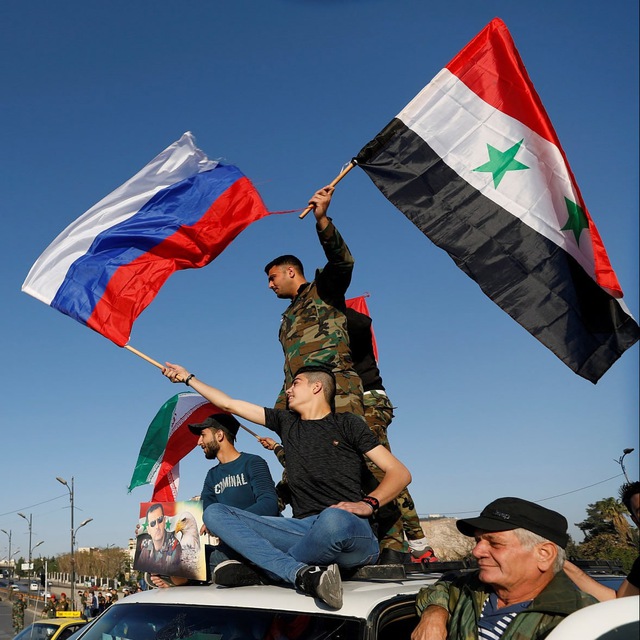"A leader in an armed faction in northwestern Iraq said he believes that the strategic objective of the operation was to “change the rules of engagement with the Russians in Syria.”
The Russian air force operates in eastern Syria to support Syrian forces fighting ISIS. This has put Russian planes in close proximity to US drones flying out of the Al-Tanf base on the Syria-Iraq border, which is occupied by US forces and allied proxy militias known as the Free Syrian Army (FSA).
According to Iraqi sources, “the Americans will also try to cut off the Iranian supply route towards Syria and Lebanon, through Iraqi territory (…). This is all we know so far.”
US and allied proxy forces occupy all border crossings between Syria and Iraq except at Al-Bukamal. Israeli officials claim the crossing is part of a “land bridge” used by Iran to move personnel and advanced weapons into Syria to confront Israel.
Despite the recent US troop movements, a leader in the Coordination Framework, a coalition of Shia forces opposed to the US presence in Iraq, said: “The faction leaders recently discussed information about the American moves, and received an Iranian message that what the Americans are doing - whatever it is - is not a cause for concern.”
On 20 August, US Central Command (CENTCOM) denied it was making any changes in the mission of the US Army in northern Syria or Iraq, including attempting to cut off the Iraq-Syria border crossing at Al-Bukamal.
CENTCOM claimed it was moving troops on the Syrian-Iraqi border, but only “in order for the outgoing unit to redeploy and the incoming personnel to assume responsibility,” as part of “a relief in place and transfer of authority.”
US troops have illegally occupied parts of northeast and east Syria since partnering with the Kurdish-led Syrian Democratic Forces (SDF) in 2015 to fight ISIS. Once the organization was defeated, US forces remained in Syria, denying the government in Damascus access to the country’s most important oil and grain-producing regions. This gives the US government leverage against the Syrian government moving forward, helping the US enforce harsh economic sanctions and hinder post-war reconstruction in the areas under government control.
US planners initially supported ISIS and other Al-Qaeda-affiliated extremist groups in Syria starting in 2011. Russian and Syrian officials allege that the US continues to support ISIS in Syria. The organization no longer holds territory but has intensified its guerrilla attacks on the Syrian army in recent weeks, killing large numbers of Syrian soldiers."
Video: US occupation forces moving a lot of gear
What’s behind the US military surge in West Asia?
"In order to counter an emerging multipolar order and its impact on West Asia, it appears that Washington’s agenda is now set on doubling down on its pre-existing regional objectives. With the advent of the Chinese-brokered rapprochement between Saudi Arabia and Iran, the heat has been on the US government to accomplish what the Biden administration views as a crowning achievement in the region: Israeli-Saudi normalization.
Short of this, to maintain the dominance of the collective west over the region, the immediate hurdle is overcoming the influences of Iran and Russia. This is why the occupation of roughly a third of Syrian territory by the US and its proxies, along with the imposition of deadly sanctions on Damascus, has become crucial in undermining the strength of its adversaries.
By keeping Syria divided and weakening the government of President Bashar al-Assad, the US is able to prevent the restoration of the Syrian state that now falls firmly under the Russian and Iranian spheres of influence.
Moreover, the recent tentative agreement between Washington and Tehran, which aimed to unlock billions in frozen Iranian assets in exchange for the release of five American prisoners, holds the potential to pave a path toward the revival of discussions to reinstate the 2015 Joint Comprehensive Plan of Action (JCPOA).
While the US’s ability to secure a renewed nuclear deal with the Islamic Republic could hypothetically create a conducive environment for Saudi-Israeli normalization, the looming specter of a potential Republican victory in the 2024 US elections may cast uncertainty over this prospect.
The use of sanctions, along with hostile intelligence measures and the deployment of troops closer to the Persian Gulf, all signal a US intent to prevent a further diminishment of their role in the region. In the wake of the Ukraine conflict, the White House’s capacity to exert its once-dominant presence in West Asia has encountered challenges, potentially prompting the current assertive stance by the US. "
deleted by creator
deleted by creator
deleted by creator
I fully support Bashar al-Assad in this. US fascist imperialism must be stopped. I’m sure the Syrian army and its IRGC allies are fully aware of the situation. I’m not the biggest fan of Iran but they’re clearly the lesser evil compared to those US insects and their proxies.
So looks like USA is not quite the paper tiger folks been saying it is?
I think that usually refers to a conflict with a peer nation, not a much weaker nation ravaged by a decade long civil war.
deleted by creator




